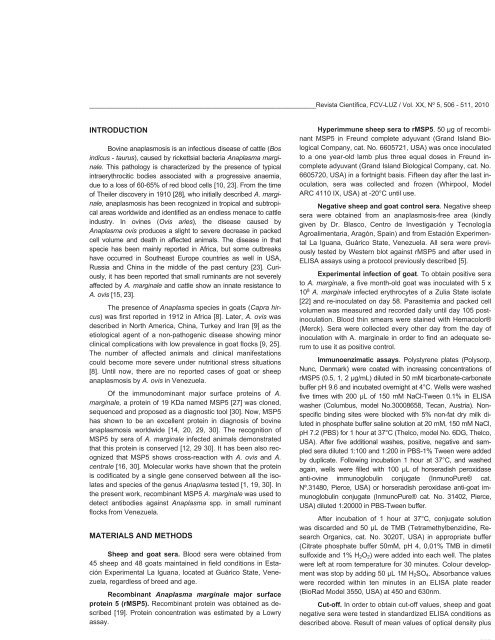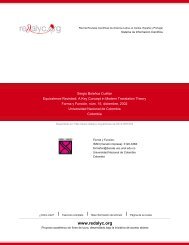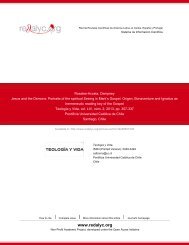Redalyc.Serological evidence of Anaplasma spp. in small ruminants ...
Redalyc.Serological evidence of Anaplasma spp. in small ruminants ...
Redalyc.Serological evidence of Anaplasma spp. in small ruminants ...
Create successful ePaper yourself
Turn your PDF publications into a flip-book with our unique Google optimized e-Paper software.
_______________________________________________________________Revista Científica, FCV-LUZ / Vol. XX, Nº 5, 506 - 511, 2010<br />
INTRODUCTION<br />
Bov<strong>in</strong>e anaplasmosis is an <strong>in</strong>fectious disease <strong>of</strong> cattle (Bos<br />
<strong>in</strong>dicus - taurus), caused by rickettsial bacteria <strong>Anaplasma</strong> marg<strong>in</strong>ale.<br />
This pathology is characterized by the presence <strong>of</strong> typical<br />
<strong>in</strong>traerythrocitic bodies associated with a progressive anaemia,<br />
due to a loss <strong>of</strong> 60-65% <strong>of</strong> red blood cells [10, 23]. From the time<br />
<strong>of</strong> Theiler discovery <strong>in</strong> 1910 [28], who <strong>in</strong>itially described A. marg<strong>in</strong>ale,<br />
anaplasmosis has been recognized <strong>in</strong> tropical and subtropical<br />
areas worldwide and identified as an endless menace to cattle<br />
<strong>in</strong>dustry. In ov<strong>in</strong>es (Ovis aries), the disease caused by<br />
<strong>Anaplasma</strong> ovis produces a slight to severe decrease <strong>in</strong> packed<br />
cell volume and death <strong>in</strong> affected animals. The disease <strong>in</strong> that<br />
specie has been ma<strong>in</strong>ly reported <strong>in</strong> Africa, but some outbreaks<br />
have occurred <strong>in</strong> Southeast Europe countries as well <strong>in</strong> USA,<br />
Russia and Ch<strong>in</strong>a <strong>in</strong> the middle <strong>of</strong> the past century [23]. Curiously,<br />
it has been reported that <strong>small</strong> rum<strong>in</strong>ants are not severely<br />
affected by A. marg<strong>in</strong>ale and cattle show an <strong>in</strong>nate resistance to<br />
A. ovis [15, 23].<br />
The presence <strong>of</strong> <strong>Anaplasma</strong> species <strong>in</strong> goats (Capra hircus)<br />
was first reported <strong>in</strong> 1912 <strong>in</strong> Africa [8]. Later, A. ovis was<br />
described <strong>in</strong> North America, Ch<strong>in</strong>a, Turkey and Iran [9] as the<br />
etiological agent <strong>of</strong> a non-pathogenic disease show<strong>in</strong>g m<strong>in</strong>or<br />
cl<strong>in</strong>ical complications with low prevalence <strong>in</strong> goat flocks [9, 25].<br />
The number <strong>of</strong> affected animals and cl<strong>in</strong>ical manifestations<br />
could become more severe under nutritional stress situations<br />
[8]. Until now, there are no reported cases <strong>of</strong> goat or sheep<br />
anaplasmosis by A. ovis <strong>in</strong> Venezuela.<br />
Of the immunodom<strong>in</strong>ant major surface prote<strong>in</strong>s <strong>of</strong> A.<br />
marg<strong>in</strong>ale, a prote<strong>in</strong> <strong>of</strong> 19 KDa named MSP5 [27] was cloned,<br />
sequenced and proposed as a diagnostic tool [30]. Now, MSP5<br />
has shown to be an excellent prote<strong>in</strong> <strong>in</strong> diagnosis <strong>of</strong> bov<strong>in</strong>e<br />
anaplasmosis worldwide [14, 20, 29, 30]. The recognition <strong>of</strong><br />
MSP5 by sera <strong>of</strong> A. marg<strong>in</strong>ale <strong>in</strong>fected animals demonstrated<br />
that this prote<strong>in</strong> is conserved [12, 29 30]. It has been also recognized<br />
that MSP5 shows cross-reaction with A. ovis and A.<br />
centrale [16, 30]. Molecular works have shown that the prote<strong>in</strong><br />
is codificated by a s<strong>in</strong>gle gene conserved between all the isolates<br />
and species <strong>of</strong> the genus <strong>Anaplasma</strong> tested [1, 19, 30]. In<br />
the present work, recomb<strong>in</strong>ant MSP5 A. marg<strong>in</strong>ale was used to<br />
detect antibodies aga<strong>in</strong>st <strong>Anaplasma</strong> <strong>spp</strong>. <strong>in</strong> <strong>small</strong> rum<strong>in</strong>ant<br />
flocks from Venezuela.<br />
MATERIALS AND METHODS<br />
Sheep and goat sera. Blood sera were obta<strong>in</strong>ed from<br />
45 sheep and 48 goats ma<strong>in</strong>ta<strong>in</strong>ed <strong>in</strong> field conditions <strong>in</strong> Estación<br />
Experimental La Iguana, located at Guárico State, Venezuela,<br />
regardless <strong>of</strong> breed and age.<br />
Recomb<strong>in</strong>ant <strong>Anaplasma</strong> marg<strong>in</strong>ale major surface<br />
prote<strong>in</strong> 5 (rMSP5). Recomb<strong>in</strong>ant prote<strong>in</strong> was obta<strong>in</strong>ed as described<br />
[19]. Prote<strong>in</strong> concentration was estimated by a Lowry<br />
assay.<br />
Hyperimmune sheep sera to rMSP5. 50 µg <strong>of</strong> recomb<strong>in</strong>ant<br />
MSP5 <strong>in</strong> Freund complete adyuvant (Grand Island Biological<br />
Company, cat. No. 6605721, USA) was once <strong>in</strong>oculated<br />
to a one year-old lamb plus three equal doses <strong>in</strong> Freund <strong>in</strong>complete<br />
adyuvant (Grand Island Biological Company, cat. No.<br />
6605720, USA) <strong>in</strong> a fortnight basis. Fifteen day after the last <strong>in</strong>oculation,<br />
sera was collected and frozen (Whirpool, Model<br />
ARC 4110 IX, USA) at -20°C until use.<br />
Negative sheep and goat control sera. Negative sheep<br />
sera were obta<strong>in</strong>ed from an anaplasmosis-free area (k<strong>in</strong>dly<br />
given by Dr. Blasco, Centro de Investigación y Tecnología<br />
Agroalimentaria, Aragón, Spa<strong>in</strong>) and from Estación Experimental<br />
La Iguana, Guárico State, Venezuela. All sera were previously<br />
tested by Western blot aga<strong>in</strong>st rMSP5 and after used <strong>in</strong><br />
ELISA assays us<strong>in</strong>g a protocol previously described [5].<br />
Experimental <strong>in</strong>fection <strong>of</strong> goat. To obta<strong>in</strong> positive sera<br />
to A. marg<strong>in</strong>ale, a five month-old goat was <strong>in</strong>oculated with 5 x<br />
10 8 A. marg<strong>in</strong>ale <strong>in</strong>fected erythrocytes <strong>of</strong> a Zulia State isolate<br />
[22] and re-<strong>in</strong>oculated on day 58. Parasitemia and packed cell<br />
volumen was measured and recorded daily until day 105 post<strong>in</strong>oculation.<br />
Blood th<strong>in</strong> smears were sta<strong>in</strong>ed with Hemacolor®<br />
(Merck). Sera were collected every other day from the day <strong>of</strong><br />
<strong>in</strong>oculation with A. marg<strong>in</strong>ale <strong>in</strong> order to f<strong>in</strong>d an adequate serum<br />
to use it as positive control.<br />
Immunoenzimatic assays. Polystyrene plates (Polysorp,<br />
Nunc, Denmark) were coated with <strong>in</strong>creas<strong>in</strong>g concentrations <strong>of</strong><br />
rMSP5 (0.5, 1, 2 µg/mL) diluted <strong>in</strong> 50 mM bicarbonate-carbonate<br />
buffer pH 9.6 and <strong>in</strong>cubated overnight at 4°C. Wells were washed<br />
five times with 200 µL <strong>of</strong> 150 mM NaCl-Tween 0.1% <strong>in</strong> ELISA<br />
washer (Columbus, model No.30008658, Tecan, Austria). Nonspecific<br />
b<strong>in</strong>d<strong>in</strong>g sites were blocked with 5% non-fat dry milk diluted<br />
<strong>in</strong> phosphate buffer sal<strong>in</strong>e solution at 20 mM, 150 mM NaCl,<br />
pH 7.2 (PBS) for 1 hour at 37°C (Thelco, model No. 6DG, Thelco,<br />
USA). After five additional washes, positive, negative and sampled<br />
sera diluted 1:100 and 1:200 <strong>in</strong> PBS-1% Tween were added<br />
by duplicate. Follow<strong>in</strong>g <strong>in</strong>cubation 1 hour at 37°C, and washed<br />
aga<strong>in</strong>, wells were filled with 100 µL <strong>of</strong> horseradish peroxidase<br />
anti-ov<strong>in</strong>e immunoglobul<strong>in</strong> conjugate (InmunoPure® cat.<br />
Nº.31480, Pierce, USA) or horseradish peroxidase anti-goat immunoglobul<strong>in</strong><br />
conjugate (InmunoPure® cat. No. 31402, Pierce,<br />
USA) diluted 1:20000 <strong>in</strong> PBS-Tween buffer.<br />
After <strong>in</strong>cubation <strong>of</strong> 1 hour at 37°C, conjugate solution<br />
was discarded and 50 µL de TMB (Tetramethylbenzid<strong>in</strong>e, Research<br />
Organics, cat. No. 3020T, USA) <strong>in</strong> appropriate buffer<br />
(Citrate phosphate buffer 50mM, pH 4, 0,01% TMB <strong>in</strong> dimetil<br />
sulfoxide and 1% H 2 O 2 ) were added <strong>in</strong>to each well. The plates<br />
were left at room temperature for 30 m<strong>in</strong>utes. Colour development<br />
was stop by add<strong>in</strong>g 50 µL 1M H 2 SO 4 . Absorbance values<br />
were recorded with<strong>in</strong> ten m<strong>in</strong>utes <strong>in</strong> an ELISA plate reader<br />
(BioRad Model 3550, USA) at 450 and 630nm.<br />
Cut-<strong>of</strong>f. In order to obta<strong>in</strong> cut-<strong>of</strong>f values, sheep and goat<br />
negative sera were tested <strong>in</strong> standardized ELISA conditions as<br />
described above. Result <strong>of</strong> mean values <strong>of</strong> optical density plus
















